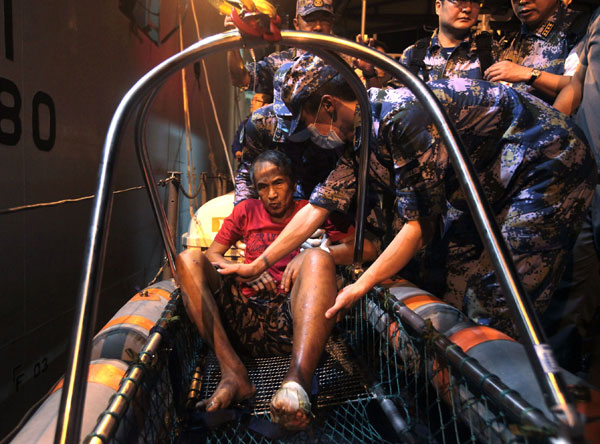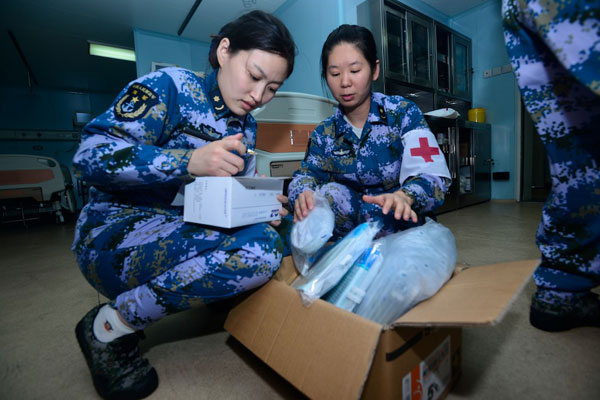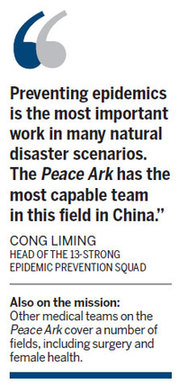Medics soon at work as Peace Ark sails in
By Peng Yining in Tacloban, the Philippines ( China Daily ) Updated: 2013-11-26 09:56:50
 |
|
Filipinos are taken to the Chinese hospital ship Peace Ark for treatment in Tacloban, the Philippines, on Sunday. Ju Zhenhua / for China Daily |
Chinese hospital ship arrives for typhoon relief efforts, reports Peng Yining in Tacloban, the Philippines.
Editor's note: On Nov 21, the Chinese hospital ship Peace Ark sailed from Zhoushan port in Zhejiang province to help with disaster relief efforts in the Philippines in the wake of a devastating typhoon. China Daily reporter Peng Yining is aboard the vessel to provide regular updates on its progress.
Mark Yoma, 42, squatted beside a small stack of burning garbage in a deserted street in Tacloban, capital of the Philippine province of Leyte.
He had hoped that the dim light cast by the flames would prompt passersby to buy a few bananas, but no one approached him.
Large areas of the Philippines were ravaged by Super Typhoon Haiyan, which made landfall on Nov 8. The death toll stands at 5,200.
As darkness fell in Tacloban, stray dogs and cats ran though the streets. Electricity has not been restored in many areas of the city.
Yoma said the typhoon destroyed his home, but a few of his banana trees survived. He now relies on donations from international relief agencies, and sells bananas to get a little extra cash.
Help arrived in Tacloban on Sunday afternoon when the Chinese hospital ship Peace Ark anchored in Leyte Gulf. By 6 pm, the vessel's medical staff had disembarked by speedboat to begin their work in the devastated city.
With help from the local government, the medics identified a suitable site for a field hospital, and late on Sunday three severely injured locals were transported to the Peace Ark for immediate surgery.
One had a fractured thighbone, another had acute appendicitis and the third had necrosis (a form of cell injury) of the lower limbs, brought on by diabetes.
The Peace Ark has 300 sickbeds, eight operating rooms, and carries 1,400 different kinds of disaster relief material weighing in at more than 35 tons. It is also equipped with a helicopter and four speedboats. The ship's medics have the materials required to build a temporary hospital on land, which can contain 50 to 100 beds.
More help required
When the typhoon struck, Sarah Cornejo and her two sisters - one of whom has heart disease - were in the family grocery store. The storm blew for the whole day and the sisters could only watch helplessly as the roof of the store was blown away. Cornejo said they huddled together to pray because, "Only God could help us."
 |
|
Medical relief workers check supplies aboard the Chinese hospital ship, Peace Ark, during the voyage to the Philippines. Mao Yu / for China Daily |
The following day they stayed with a neighbor, but were later transferred to the city's only surviving hospital, where they are recuperating.
"We lost everything in the disaster," said Cornejo, "but at least we have each other." As she spoke, the 18-year-old leaned over her sick sister's bed and waved a white paper fan to drive away the mosquitoes.
Hot and humid, the hospital was flooded with patients, who sat on the ward floors or spilled out into the corridors. Hospital chief, Aileen Espina, said that when the typhoon first struck, chest-high water flooded the ground floor, forcing staff to move patients to the second floor. The hospital currently has 181 patients, but medical staff and medicine are urgently needed. "Even in these difficult times the hospital is open, but we need more help. I'm glad that the
Lyn Wilo, 30, was attending to her sick and frightened 82-year-old grandmother, who is being treated at the hospital. Wilo said the storm was so strong that cracks appeared in their home, allowing rain and seawater to flood the building.
She helped her grandmother to escape the house and the two women fled to a nearby school. "Thanks to the international aid effort, we now have clean food and water," said Wilo. "But who will help us to repair our houses?"
Song Hongbin is a medical expert aboard the Peace Ark. When he first saw the news of the devastating typhoon on the television, the first thought that entered his mind was, "I can help!"
The 45-year-old expert in infectious diseases at the Academy of Military Medical Sciences' Institute of Disease Control and Prevention, also participated in the 2010 relief efforts in Haiti. He said the locals warmly welcomed the Chinese medical team, whose careful, professional work soon gained them a good reputation. When the team finished its mission, many local people were sad to see the doctors depart, he said.
"When we were sitting on a bus, ready to leave, a middle-aged man held my hand through the window. He had tears in his eyes," said Song. "In Haiti, I saw the devastating effect natural disasters can have on people's lives and how badly the survivors needed help. The people in the damaged areas of the Philippines also deserve care and help from other countries, including China."
Song said he had been waiting for the call to go to the Philippines since he first heard the news about Typhoon Haiyan. On Nov 20, he boarded the Peace Ark, which set sail for the Philippines the next day.
With a medical contingent of 128, backed up by state-of-the-art equipment, the ship's officers planned to begin the relief efforts in Samar, one of the areas worst affected.
